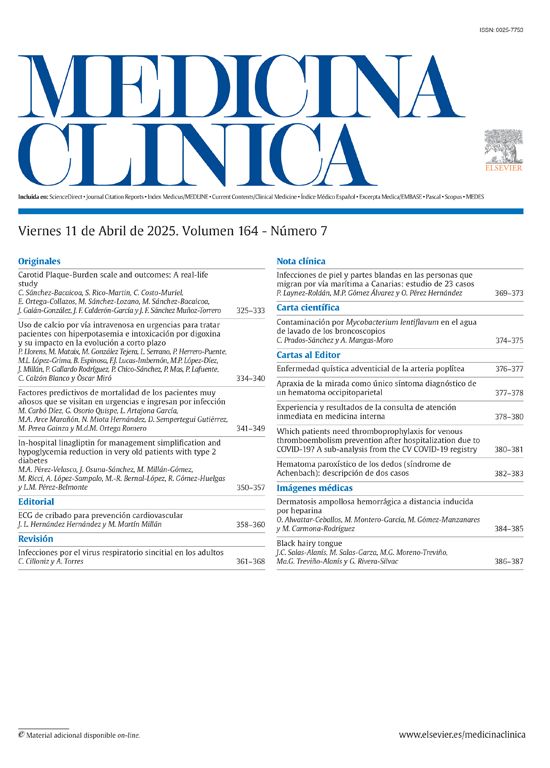Evaluar si los pacientes con fibrilación auricular crónica atendidos en un centro de salud siguen un tratamiento antitrombótico correcto.
Pacientes y métodoEstudio descriptivo transversal, en el que se incluyó a 416 pacientes diagnosticados de fibrilación auricular crónica, de una población de 28.847 pacientes. Se recogieron las siguientes variables: edad, sexo, factores de riesgo embolígeno, tratamiento antitrombótico pautado, condicionantes y contraindicaciones para la anticoagulación, tratamiento antitrombótico correcto o no y estratificación del riesgo. Tras un análisis bivariante, realizamos un modelo de regresión logística para analizar las variables asociadas a un riesgo de mal tratamiento.
ResultadosEl 81% recibía tratamiento antitrombótico correcto, un 96,8% se hallaba en fibrilación auricular valvular y un 78,2%, en no valvular. A mayor edad, el porcentaje de pacientes con mal tratamiento antitrombótico fue mayor (t = 3,184; p = 0,002). Un mayor riesgo embolígeno se asoció a mejor tratamiento antitrombótico (p < 0,001). La existencia de al menos un factor de riesgo se asoció a un tratamiento correcto (p < 0,001). Entre los factores de riesgo, sólo la hipertensión arterial, la valvulopatía mitral y la presencia de prótesis valvular tenían significación estadística.
En el análisis multivariante, la calidad de vida limitada (odds ratio [OR] = 0,13; intervalo de confianza [IC] del 95%, 0,02–0,59), la existencia de valvulopatía mitral (OR = 0,13; IC del 95%, 0,03–0,57), la hipertensión arterial (OR = 0,36; IC del 95%, 0,20–0,63) y el antecedente de embolia sistémica (OR = 0,41; IC del 95%, 0,17–0,99) se comportaron como factores protectores de un mal tratamiento. La edad superior a 80 años se asoció a un riesgo de mal tratamiento 2,89 veces mayor que el de las personas de esa edad o menores (OR = 2,89; IC del 95%, 1,68–4,95).
ConclusionesEn nuestro centro, la mayoría de los pacientes con fibrilación auricular crónica, valvular y no valvular, reciben un tratamiento antitrombótico correcto, y la edad es el factor que más se asocia a un mal tratamiento.
Our goal was to evaluate the appropriateness of antithrombotic treatment administration in patients with chronic atrial fibrillation (CAF) attended in a health primary center.
Patients and methodTransverse and descriptive study; 416 patients diagnosed with CAF were included out of a population of 28,447. Age, sex, embolism risk factors, antithrombotic therapy, contraindications to anticoagulation and stratification risk variables were collected. After a bivariate analysis, a logistic regression model was done to analyze the variable associated with an incorrect antithrombotic therapy.
Results81% patients were given a correct antithrombotic therapy: 96.8% with a valvular-CAF pattern and 78.2% with a non-valvular CAF pattern. Older the patient, higher the percentage of incorrect antithrombotic administration (t = 3.184; p = 0.002). A greater embolic risk was associated with a better antithrombotic treatment (p < 0.001). The existence of at least one risk factor was also associated with a correct administration (p < 0.001). Hypertension, mitral valvular heart disease and valvular prosthesis were factors associated with a correct antithrombotic therapy. In a multivariate analysis, limited quality of life, mitral valvular heart disease, hyper-tension and previous systemic embolism behaved all as protective factors of a wrong treatment. An age older than 80 years was associated with a risk of treatment which was 2.89 times higher than that of individuals with the same age or youngers (OR = 2.89; 95% CI, 1.68–4.95).
ConclusionsMost patients with CAF, both valvular and non-valvular, were properly given antithrombotic therapy. The main factor associated with an incorrect antithrombotic therapy was advanced age.







